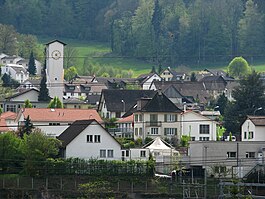Killwangen
| Killwangen | ||
|---|---|---|
 |
||
|
||
| Coordinates: 47°26′N 8°21′E / 47.433°N 8.350°ECoordinates: 47°26′N 8°21′E / 47.433°N 8.350°E | ||
| Country | Switzerland | |
| Canton | Aargau | |
| District | Baden | |
| Area | ||
| • Total | 2.43 km2 (0.94 sq mi) | |
| Elevation | 393 m (1,289 ft) | |
| Population (Dec 2015) | ||
| • Total | 1,960 | |
| • Density | 810/km2 (2,100/sq mi) | |
| Postal code | 8956 | |
| SFOS number | 4030 | |
| Surrounded by | Neuenhof, Oberrohrdorf, Spreitenbach, Würenlos | |
| Website |
www SFSO statistics |
|
Killwangen is a municipality in the district of Baden in the canton of Aargau in Switzerland.
The town was first known as Chullewangen as early as 1227. The name is alemannish in origin. For nearly 600 years, Killwangen was dependent on the monastery in nearby Wettingen. In 1798, Napoleon's troops came through Switzerland and the Helvetic Republic was born. Killwangen was part of the Canton of Baden which enjoyed a short history as a separate Canton, being absorbed by the new Canton of Aargau in 1803. On 7 August 1847, the first railway line in Switzerland opened between Baden and Zurich. On 1 February 1848, the town received its own railways station on the pioneer line.
Killwangen has an area, as of 2006[update], of 2.4 km2 (0.93 sq mi). Of this area, 27.6% is used for agricultural purposes, while 50.6% is forested. Of the rest of the land, 19.3% is settled (buildings or roads) and the remainder (2.5%) is non-productive (rivers or lakes).
The town lies in the Limmat valley between Baden and Zürich. Killwangen lies on the south side of the Limmat river, within easy walking distance of the Heitersberg. Elevation of the Limmat at Killwangen is 385 m (1,263 ft) a.s.l. The highest point in Killwangen is the Sennenberg ridge at 702 m (2,303 ft). Neighboring towns are Wurenlos to the North, Spreitenbach to the east, Neuenhof to the West and Oberrohrdorf to the south.
The blazon of the municipal coat of arms is Gules a Mullet Argent under a Chevron rose of the same.
Killwangen has a population (as of 31 December 2015) of 1,960. As of 2008[update], 23.6% of the population was made up of foreign nationals. Over the last 10 years the population has grown at a rate of 30.7%. Most of the population (as of 2000[update]) speaks German (88.2%), with Italian being second most common ( 2.7%) and Serbo-Croatian being third ( 1.9%).
...
Wikipedia




